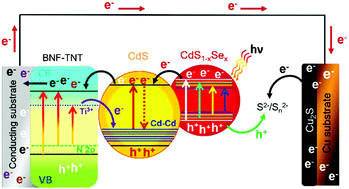Hidden energy levels? Carrier transport ability of CdS/CdS1−xSex quantum dot solar cells impacted by Cd–Cd level formation†
Abstract
In quantum dot sensitized solar cells (QDSSC), a cascade energy level structure controlled by assembly of cadmium–chalcogenide quantum dots can remarkably improve the sunlight harvesting and charge carrier lifetime. Despite the advantages of using co-sensitizers, energy conversion efficiencies are still low. An increased understanding of the causes of the low photoconversion efficiency (PCE) will contribute to the development of a straightforward approach to improve solar cell performance by exploiting co-sensitization. Herein we discuss how an excess of cadmium causes structural disorder and defect levels impacting the PCE of QDSSC devices. Thus, outer CdS1−xSex/inner CdS QD-co-sensitized B,N,F-co-doped-TiO2 nanotubes (BNF-TNT) were prepared. Chalcogenides were deposited by the SILAR method on BNF-TNT, varying the load of CdS as the inner sensitizer, while for CdS1−xSex, five SILAR cycles were used (5-CdS1−xSex), controlling the nominal S/Se molar ratio of the ternary alloy. Cd defects named as Cd–Cd energy levels were observed during CdS sensitization. Although incorporation of outer CdS1−xSex provides a tunable band gap to achieve good band alignment for carrier separation, Cd–Cd energy levels in the sensitizers act as recombination centers, limiting the overall electron flow at the BNF-TNT/CdS/CdS1−xSex interface. A maximum PCE of 2.58% was reached under standard AM 1.5G solar illumination at 100 mW cm−2. Additional limitations of SILAR as a deposition strategy of QDs are also found to influence the PCE of QDSSC.



 Please wait while we load your content...
Please wait while we load your content...